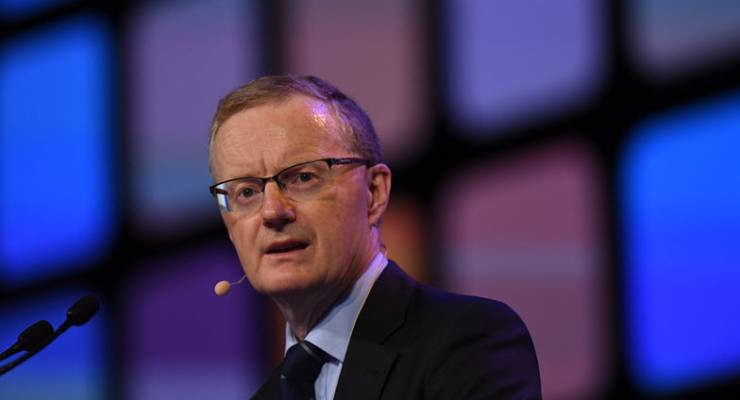
“There are signs the economy may have reached a gentle turning point,” Reserve Bank governor Philip Lowe told parliament’s Economics Committee on Friday. What he didn’t say — but what would be confirmed a couple of hours later — was that the turning point, if ever reached, was going to lead to a tepid economy not particularly different to the stagnant, low-growth mess we’re now in.
Appearing before a committee chaired by Liberal MP Tim Wilson, you could forgive Lowe for some sleight of hand in his opening statement. Wilson — that brave tribune of wealthy retirees against the interests of millions of workers and their families — has of late simultaneously managed to attack the RBA for cutting interest rates (hurts his rich seniors mates) while also criticising it for not doing enough to stimulate the economy.
So while the committee mulled over Lowe’s possible turning point, the RBA was preparing its August Statement of Monetary Policy, which showed just how bad the economic landscape around it actually is.
The statement revises forecasts down further across a number of major indicators from the last effort in May. Household consumption growth has been revised down significantly, and won’t reach 2.5% growth until 2021. Unemployment won’t fall below 5% until the end of 2021. The Wage Price Index — we’ll get the June quarter number this week — will still be stuck at the heady heights of 2.4% at the end of 2021, compared to 2.6% in the May statement.
As recently as February, non-farm average earnings per hour was forecast to grow at 3% from late next year; that’s now been revised down to 2.6%. CPI won’t return to the bank’s target band until 2021. Dwelling investment forecasts has also been sharply downgraded in the near-term, but are now tipped to fall less than previously forecast in coming years.
Our terms of trade will also deteriorate sharply, but that’s to be expected given the dramatic ramp-up beyond forecasts of commodity prices this year. And the bank expects GDP growth to return to 3% by mid-2021 — an upward revision. Though let’s not forget it was only last November that the bank was confidently predicting growth above 3% all the way through the coming years, before dramatically lowering forecasts in the wake of rotten GDP numbers in the first two quarters of 2018-19.
All up, it’s probably the weakest forecast since the financial crisis. Moreover, “domestically, the near-term risks to growth are more to the downside”, the RBA warns.
Some leading indicators suggest that employment growth could moderate by more than forecast, which could lead to lower than expected growth in household incomes and consumption. Conditions in the earlier stages of residential development remain weak, which raises the risk that dwelling investment will decline by more than currently forecast.
At the heart of all this is weak wage growth — something Lowe addressed in his opening statement. “Upward pressure on wages growth over the next couple of years is likely to be only quite modest,” he said. What he didn’t add was that the RBA is now forecasting declining growth in real wages: WPI minus CPI will be 0.6% this calendar year, o.4% in 2020 and 0.3% in 2021.
This is the government’s deliberate strategy of wage stagnation in action, when it actually has one very easy lever to lift wages growth.
“Caps on wages growth in public sectors right across the country are another factor contributing to the subdued wage outcomes,” Lowe said. “At the aggregate level, my view is that a further pick-up in wages growth is both affordable and desirable.”
Real wages growth declining from its already negligible level means more pressure on household incomes, spending and debt. No wonder the 10 year bond yield — the best market guide to future moves on inflation and growth — fell under the 1% RBA cash rate to end the week at 0.95%, the lowest on record (again).
A 23 point fall in bonds yields in a week is a big signal from markets that they are increasingly worried that Australia could stumble into a recession in the next year or so.
If it happens, it will have been one engineered by a government that has facilitated wage stagnation for what, by the end of 2021, will be more than eight years.









The question is; was it explicitly ‘inaction’ by the current Government that largely caused this poor result?
And the muppet government has only one strategy – expect an outbreak of economic activity when a real surplus is achieved – what and offing joke!
I also take issue with the claim that the muppet government has ‘engineered’ stagnant wages growth. This mob could not ‘engineer’ a chook raffle. Stagnant wage growth is a consequence of this government basically doing nothing other than dog whistling right wing culture war tunes.
Talking Heads….
“Well we know where we’re going
But we don’t know where we’ve been
And we know what we’re knowing
But we can’t say what we’ve seen
And we’re not little children
And we know what we want
And the future is certain
Give us time to work it out …..”
“that brave tribune of wealthy retirees against the interests of millions of workers and their families“ LOL…….. you left out the bit about the struggling pensioners and the “millions” of house flippers and speculators.
Well ………….who’s counting really ❓
Anybody that does`nt understand that morrison and his conservative government have deliberately engineered this recession as their the last action of their destroy the unions manifesto is either blind or stupid or maybe both, this has been their plan since john Howard was thrown out of office and lost his seat, the ultimate revenge and payback to the union movement that destroyed him and his workchoices program in 2007.